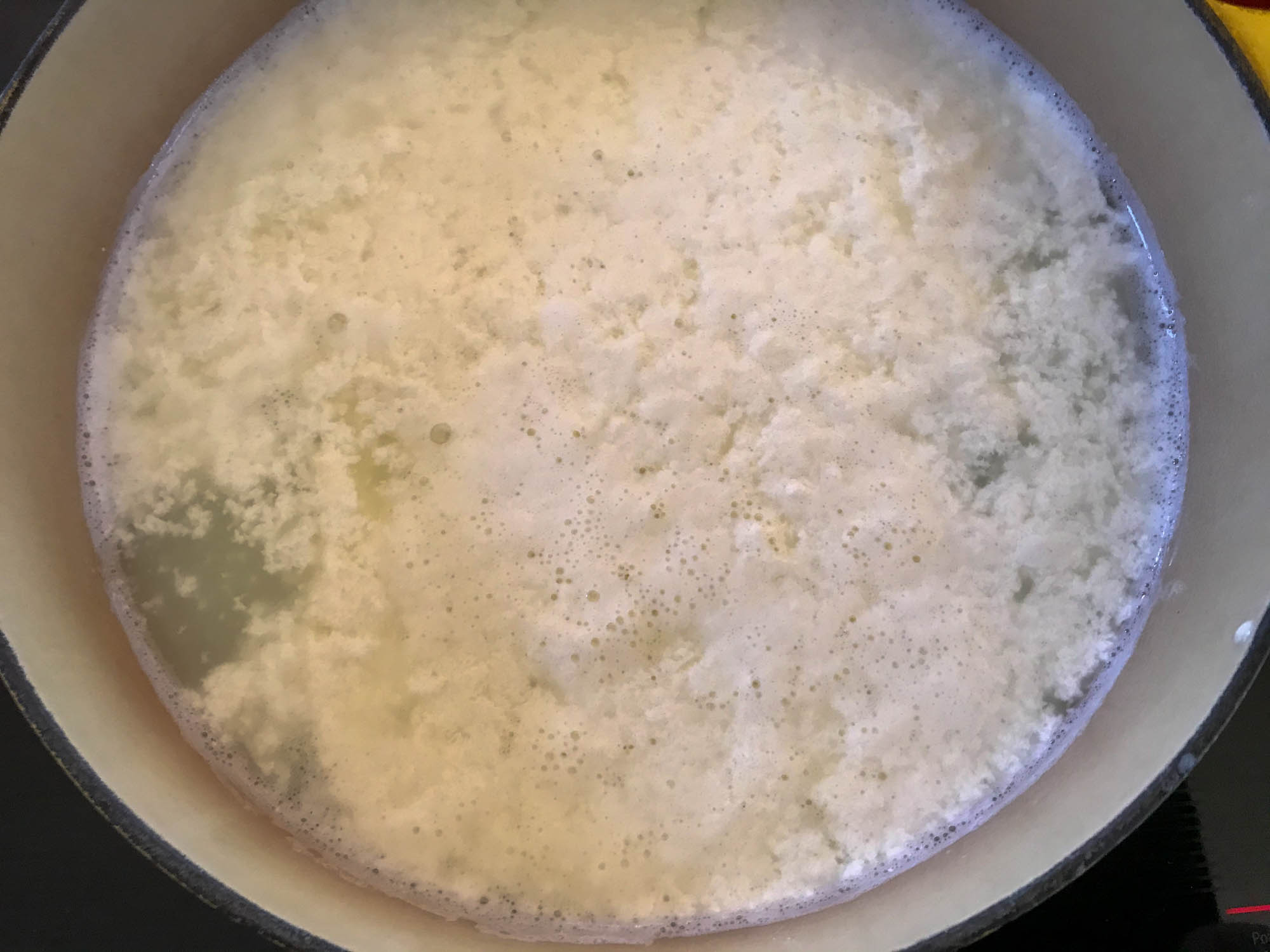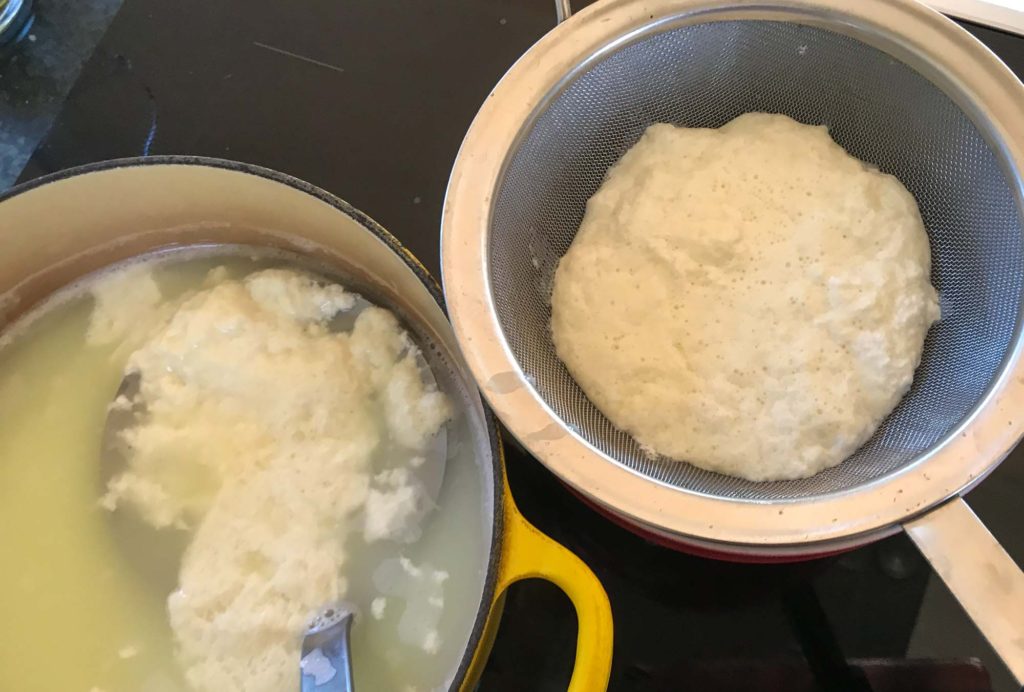A semi-pro fresh ricotta cheese made with raw milk.
-Full Post-

You'll need a good, thick saucepan, a skimmer with a mesh screen or small holes, a strainer or official ricotta basket, and a fast-acting thermometer. Start by dissolving the citric acid crystals in the warm water. With luck, you won't need more than half of the liquid. We'll see.

Start warming the milk over medium-high heat, stirring frequently enough to keep it from coating the bottom of the pan. Test the temperature frequently, turning the heat down to medium as you approach 165 degrees F.
When the milk hits 165, add just 1 tablespoon of the acid solution. From this point forward, keep stirring to a minimum - just float the spoon around gently. You're looking for the proteins to curdle up into a watery mass, clearly separate from the watery, greenish whey. If this doesn't happen within a minute or two, add another tablespoon of the acidulated water.
If there's still no joy and your milk is between 165 and 170, you can try a bit more heat and a bit more acid. But I'm betting two tablespoons (that is, one teaspoon of dissolved citric acid) will be enough. Let's imagine it is.
Continue letting the heat build up, monitoring it carefully and not letting it get beyond 195 degrees F - remove from the heat completely a few degrees before that. The ricotta will improve, and you'll get a better yield, with a five minute rest between 185 and 195. Stir only gently and occasionally, to let the curds huddle up and float - you only want to keep them from sticking to the sides or the very bottom of the pan.
After their relaxing bath, skim the curds off into a strainer set over a small bowl. The longer it sits and drains, the drier the end product - 10 minutes is about right for most uses. Stir it up, adding just a pinch of salt if you like, and refrigerate. Keeps well for about five days.
Such a simple thing, and yet so variable. Your yield will be around a cup of lovely ricotta for a half-gallon of milk, but it will weigh around 10 or 12 ounces, and go a long way. You are advised to avoid ultra-pasteurized milk (warning - many organic brands are ultra pasteurized), as this flash-heating process affects the protein structure and they may not want to separate at all.
If you find a milk that works well, stick with it. My very good friends at New England Cheesemaking Supply can help you with citric acid, official ricotta baskets, additional recipes and excellent advice. Given a zip code, they can even tell you where to get good milk in your area.
It's tough not to eat this ricotta straight up for breakfast with some fresh fruit, but try my recipes for nestling it next to a pie, making naked spanakopita, or turning pumpkin ravioli inside out.
Ingredients
Directions
You'll need a good, thick saucepan, a skimmer with a mesh screen or small holes, a strainer or official ricotta basket, and a fast-acting thermometer. Start by dissolving the citric acid crystals in the warm water. With luck, you won't need more than half of the liquid. We'll see.

Start warming the milk over medium-high heat, stirring frequently enough to keep it from coating the bottom of the pan. Test the temperature frequently, turning the heat down to medium as you approach 165 degrees F.
When the milk hits 165, add just 1 tablespoon of the acid solution. From this point forward, keep stirring to a minimum - just float the spoon around gently. You're looking for the proteins to curdle up into a watery mass, clearly separate from the watery, greenish whey. If this doesn't happen within a minute or two, add another tablespoon of the acidulated water.
If there's still no joy and your milk is between 165 and 170, you can try a bit more heat and a bit more acid. But I'm betting two tablespoons (that is, one teaspoon of dissolved citric acid) will be enough. Let's imagine it is.
Continue letting the heat build up, monitoring it carefully and not letting it get beyond 195 degrees F - remove from the heat completely a few degrees before that. The ricotta will improve, and you'll get a better yield, with a five minute rest between 185 and 195. Stir only gently and occasionally, to let the curds huddle up and float - you only want to keep them from sticking to the sides or the very bottom of the pan.
After their relaxing bath, skim the curds off into a strainer set over a small bowl. The longer it sits and drains, the drier the end product - 10 minutes is about right for most uses. Stir it up, adding just a pinch of salt if you like, and refrigerate. Keeps well for about five days.
Such a simple thing, and yet so variable. Your yield will be around a cup of lovely ricotta for a half-gallon of milk, but it will weigh around 10 or 12 ounces, and go a long way. You are advised to avoid ultra-pasteurized milk (warning - many organic brands are ultra pasteurized), as this flash-heating process affects the protein structure and they may not want to separate at all.
If you find a milk that works well, stick with it. My very good friends at New England Cheesemaking Supply can help you with citric acid, official ricotta baskets, additional recipes and excellent advice. Given a zip code, they can even tell you where to get good milk in your area.
It's tough not to eat this ricotta straight up for breakfast with some fresh fruit, but try my recipes for nestling it next to a pie, making naked spanakopita, or turning pumpkin ravioli inside out.

Leave a Reply